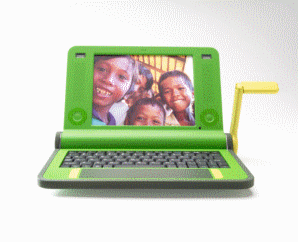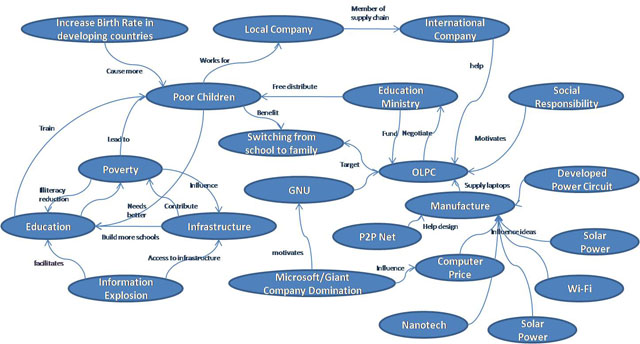Difference between revisions of "The future of the $100 laptop in 2017"
Lovelyxinxin (talk | contribs) |
|||
| Line 48: | Line 48: | ||
=Scenarios= | =Scenarios= | ||
=Frequently Asked Questions= | =Frequently Asked Questions= | ||
Why do children in developing nations need laptops? | |||
Laptops are both a window and a tool: a window into the world and a tool with which to think. They are a wonderful way for all children to "learn learning" through independent interaction and exploration. | |||
What is the alternative for education? The laptop is cheaper than two or three ordinary textbooks, but gives access to the entire wealth of information on the Internet. This is for children who cannot walk to a library, and are out of range of any kind of television, educational, commercial, or otherwise. | |||
What is the $100 Laptop, really? | |||
The proposed $100 machine will be an innovative hardware design, based on Linux, with a dual-mode display—both a full-color, transmissive DVD mode, and a second display option that is black and white reflective and sunlight-readable at 3× the resolution. The laptop will have a 500MHz processor and 128MB of DRAM, with 500MB of Flash memory; it will not have a hard disk, but it will have three USB ports. The laptops will have wireless broadband that, among other things, allows them to work as a mesh network; each laptop will be able to talk to its nearest neighbors, creating an ad hoc, local area network. This is a special low power, extended range wifi with its own CPU that allows data transmission to continue while the main CPU is sleeping, e.g., during transport in a backpack. The laptops will use a wide range of DC power inputs (including wind-up) and will be able to do most everything except store huge amounts of data. We expect that some units will be adapted to special uses by adding USB peripherals. | |||
Is this project really about getting computers to kids? | |||
The answer is an unequivocal yes! But it doesn't stop there. We also want to get millions of textbooks to kids and give them an excellent education as well. This is an education project, not a laptop project. | |||
Child is a nebulous term; what is the exact age range you are targeting? | |||
We are hoping to reach elementary and secondary-school-age children: ages 6 to 18 years. | |||
=References= | =References= | ||
Revision as of 21:51, 20 March 2007
Introduction
|
|
The "$100 laptop" is a more popular name for a project set up by One Laptop per Child (OLPC) association. The $100 laptop was a result of research initiative by MIT Media Lab in January 2005 in its effort to create a technology that will revolutionise child education in the world.
One Laptop per Child (OLPC) is a non-profit organisation that was established to achieve its goal. It is independent of MIT and is strongly sending the message to the world that this is not a laptop project but an education project.
Children in rural areas--especialy in developing countries--have very little, if not deprived of, access to school. The conventional solution to this issue is to build a school and train teachers. But it is perhaps the slowest way. OLPC is a breakthrough that will give the rights to education to these children.
At the end of November 2006, the $100 laptop was proudly presented to the public. Despite the price and the intended users, the machine boasts a remarkable complete sets of software that helps broaden the mind and creativity of a child. This was made possible by the strong support of open-source community in building this system so that the price can be kept low.
Our research is to study the future of this education project in 2017 considering various driving forces from technological to socio-political aspects. The motivation behind this research choice is the noble and excellent idea of this project as well as the technology applications in it.
Aki - updated Thursday, 15 March 2007 5:23 PM
Research Questions
Click here for our Our Research Questions
Driving Forces
- Political & Social Forces
- Economic Forces
- Science & Technology Forces
- Resource & Environment Forces
- Population & Demographic Forces
Diagrams
Scenarios
Frequently Asked Questions
Why do children in developing nations need laptops? Laptops are both a window and a tool: a window into the world and a tool with which to think. They are a wonderful way for all children to "learn learning" through independent interaction and exploration.
What is the alternative for education? The laptop is cheaper than two or three ordinary textbooks, but gives access to the entire wealth of information on the Internet. This is for children who cannot walk to a library, and are out of range of any kind of television, educational, commercial, or otherwise.
What is the $100 Laptop, really? The proposed $100 machine will be an innovative hardware design, based on Linux, with a dual-mode display—both a full-color, transmissive DVD mode, and a second display option that is black and white reflective and sunlight-readable at 3× the resolution. The laptop will have a 500MHz processor and 128MB of DRAM, with 500MB of Flash memory; it will not have a hard disk, but it will have three USB ports. The laptops will have wireless broadband that, among other things, allows them to work as a mesh network; each laptop will be able to talk to its nearest neighbors, creating an ad hoc, local area network. This is a special low power, extended range wifi with its own CPU that allows data transmission to continue while the main CPU is sleeping, e.g., during transport in a backpack. The laptops will use a wide range of DC power inputs (including wind-up) and will be able to do most everything except store huge amounts of data. We expect that some units will be adapted to special uses by adding USB peripherals.
Is this project really about getting computers to kids? The answer is an unequivocal yes! But it doesn't stop there. We also want to get millions of textbooks to kids and give them an excellent education as well. This is an education project, not a laptop project.
Child is a nebulous term; what is the exact age range you are targeting? We are hoping to reach elementary and secondary-school-age children: ages 6 to 18 years.
References
Related Links
<pagerating from="Bad" to="Good" category="Scenario">Rate this page</pagerating>


